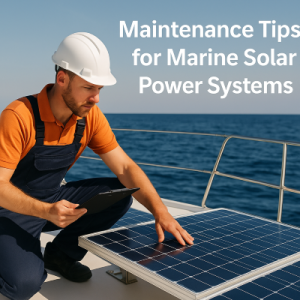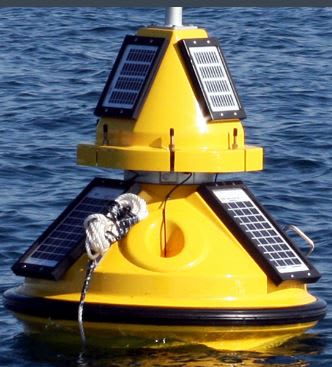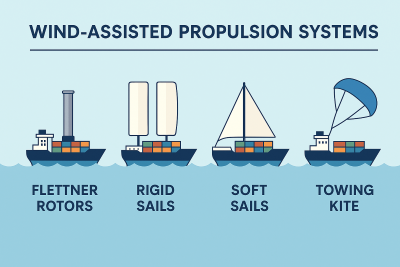Maintenance Tips for Marine Solar Power Systems
As an increasing number of sailors, boat owners, and marine industry experts embrace renewable energy, marine solar power systems are becoming essential on vessels of various sizes. They provide clean, quiet, and low-maintenance energy—but, like any marine equipment, they still need regular attention to function optimally.
In this blog entry, we will guide you through key maintenance suggestions that will maximize the effectiveness of your solar power system while out on the water. Whether you’re sailing full-time or enjoy weekend outings, these recommendations will help keep your panels efficient, your batteries in good condition, and your power dependable.
Why Marine Solar Power Systems Need Regular Maintenance?

Let’s face it—saltwater, humidity, and continuous movement can affect any equipment. Although solar panels are generally robust and designed to endure for many years, the marine setting is especially tough. Without adequate maintenance, efficiency can decline sharply, resulting in power shortages when you need electricity the most.
Additionally, overlooking maintenance can lead to corrosion, faulty connections, and ultimately higher repair or replacement expenses. This is why establishing a proactive maintenance schedule isn’t just wise rather it’s essential.
-
Regularly Clean Your Solar Power Panels
Salt, Dust, and Bird Droppings: The Common Suspects
The Common Culprits One of the simplest yet frequently neglected maintenance task is keeping your solar panels clean. Over time, salt spray, grime, and even bird droppings can build up on the surface, obstructing sunlight and diminishing efficiency.
How often?
- In salt-rich environments, clean them every two weeks.
- For freshwater or inland vessels, a monthly cleaning might be enough.
How to clean:
- Use fresh water, a soft sponge or microfiber cloth, and a gentle detergent (if necessary).
- Avoid harsh chemicals or abrasive materials, as they can scratch the protective coating of the panels.
- Rinse thoroughly and dry with a clean cloth to avoid water spots.
-
Inspect Electrical Connections
Tighten, Check, and Protect
- Tighten, Examine, and Safeguard Loose or corroded connections can silently undermine your solar system’s efficiency.
- Every few weeks, conduct a visual inspection of your wiring and connectors.
What to look for:
- Signs of corrosion, especially around the terminals.
- Frayed or damaged wires.
- Loose junction boxes or cable runs.
Tips:
- Apply dielectric grease to metal terminals to prevent oxidation.
- Whenever possible, use marine-grade heat-shrink tubing and waterproof connectors.
3. Keep an Eye on Battery Health
Your marine solar panels may be harnessing sunlight, but if your batteries aren’t in optimal condition, you won’t be storing energy effectively. Maintenance of solar batteries is equally important.
Look for:
- Voltage consistency using a multimeter.
- Appropriate electrolyte levels (for lead-acid batteries).
- Signs of swelling, overheating, or leaking.
Extra tip:
Consider investing in a battery monitoring system that provides real-time data on charging, discharging, and overall battery health. This will help you identify issues before they escalate into costly problems.
-
Watch for Shading Concerns
Even minimal shading on a single solar panel can significantly diminish total energy output. Sadly, boats are ever-changing environments where equipment, sails, or even birds can create shading.
Recommended practices:
- Regularly inspect for blockages.
- Place panels away from tall structures like masts and radar arches.
- If possible, utilize MPPT (Maximum Power Point Tracking) charge controllers, which optimize performance even in partially shaded conditions.
-
Update Firmware and Software
Were you aware that numerous marine solar charge controllers and inverters have updatable firmware? Manufacturers occasionally issue performance enhancements or bug resolutions, so it’s beneficial to check periodically.
Steps to take:
- Go to the manufacturer’s website and look for your product model.
- Download the most recent firmware.
- Meticulously follow the provided instructions (typically via USB or app).
Keeping your system’s software current ensures maximum efficiency and safety.
-
Protect Against Moisture and Corrosion
In the marine environment, moisture poses a significant threat. Even “sealed” parts can become susceptible over time.
Preventive Actions:
- Store charge controllers and batteries in ventilated yet dry areas.
- Apply anti-corrosion sprays on electrical connections.
- Monitor for condensation accumulation in housing boxes, particularly after significant weather changes.
-
Secure Your Panels and Mounting Systems
Given the constant motion, wind, and waves, it’s crucial that your solar panels and their mounting systems are firmly secured.
What to Inspect:
- Bolts and fasteners: Are they secure?
- Mounting brackets: Any indications of rust or deterioration?
- Swivel or tilt mechanisms: Are they operating as intended?
Loose panels can vibrate, causing micro-cracks that may not be immediately visible but will reduce panel performance over time.
-
Monitor System Output
One of the most effective ways to determine if your system is underperforming is to track its output consistently.
Employ monitoring tools such as:
- Solar charge controller displays
- Mobile applications (Bluetooth or Wi-Fi enabled)
- Manual logs for weekly energy production records
If you observe a decline in energy generation without an obvious cause, it might be time for a more thorough examination.
Bonus Tip: Maintain a Log of Maintenance
Keeping a straightforward maintenance log can assist you in tracking trends, planning battery replacements, and identifying potential issues early. Document dates, types of maintenance performed, any changes in system output, and observations regarding component wear.
Final Thoughts
Admittedly, maintaining a marine solar power system isn’t overly challenging; however, it does demand consistent attention. In fact, even a small amount of proactive care can go a long way toward significantly enhancing reliability and ensuring sustainable energy throughout your journey at sea. Moreover, by integrating routine checks and smart upkeep into your schedule, you’ll not only prevent unexpected failures but also extend your system’s lifespan.
All things considered, maintaining a marine solar power system ultimately revolves around staying proactive. Therefore, don’t wait for issues to arise—roll up your sleeves, dive into the details, and give your equipment the regular attention it truly deserves. After all, a little effort now can save you a great deal of trouble later.



